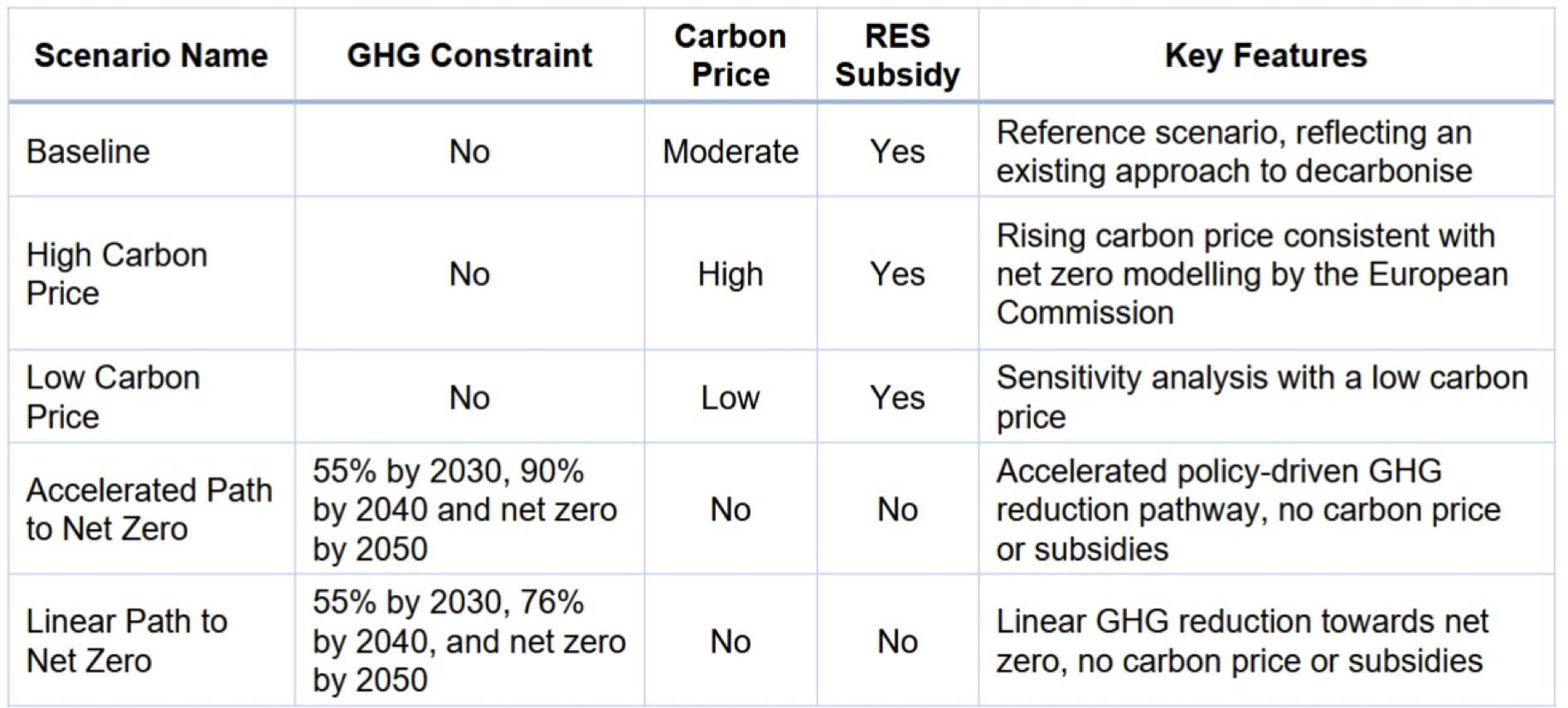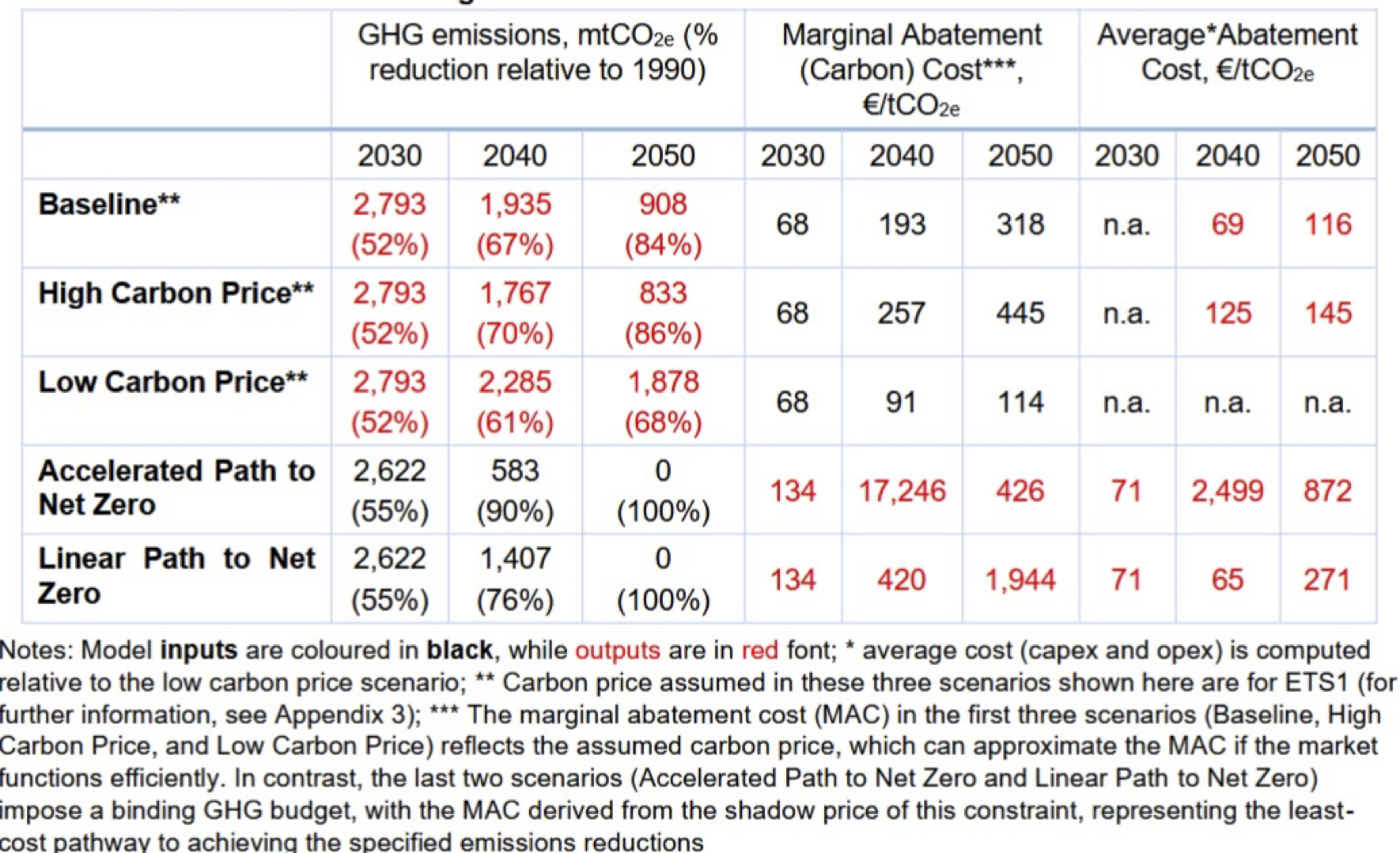The Oxford Institute for Energy Studies (OIES) recently published the results of the study on the costs of decarbonisation by 2050.
The Oxford Institute for Energy Studies (OIES) has recently published the results of the study on the costs of decarbonisation in the EU27, UK, Norway and Switzerland until 2050, including the interim targets for 2030 and 2040.
The OIES, Dr Kong Chyong, has modelled the Marginal Abatement (Carbon) Cost (MAC), i.e. the marginal cost of avoiding CO2eq emissions, and the Average Abatement Cost (AAC), i.e. the average cost of avoiding CO2eq emissions, both in €/tCO2eq, based on the EC's assumptions regarding CO2eq emission prices and compliance with the CO2eq reduction targets (reduction compared to 1990 by 55% by 2030, by 90% by 2040 and Net Zero by 2050). (Marginal abatement costs are the costs incurred by avoiding an additional tonne of CO2eq).
The following scenarios, described in the table below (table taken from the report), were assumed.

For the first three scenarios, no CO2eq emission limit values were assumed, but CO2eq emission prices (basis 2023) that are consistent with the relevant assumptions of the EC and can be taken from the following table.

The two "Accelerated Path to Net Zero" scenarios depict the path specified by the EC with regard to maximum CO2eq emission values. The "Linear Path to Net Zero" scenario was assumed as an alternative scenario to the "Accelerated Path to Net Zero" and shows the effects of a linear reduction in CO2eq emissions by 2050 - i.e. avoiding the very steep (almost "sudden") reduction between 2030 and 2040. The main advantage of the linear reduction is the time "gained", because by 2040 some technologies - such as carbon capture and storage (CCS) - will not yet be available - or not to the full extent - and the costs of avoiding CO2eq emissions from other, alternative technologies would therefore be very high. For example, high-temperature heat pumps have not yet reached the necessary technology readiness level - not to mention the commercial readiness level and the necessary market penetration until saturation.
The assumptions regarding the development of energy consumption in the individual sectors (industry, buildings, transport, etc.) and the expansion limits for the installation of PV, wind power plants, run-of-river power plants and pumped storage are incorporated into the model with plausible assumptions, as are the full load hours. This results in the values shown in the table below. The results of the model are shown in red and the model inputs in black. With regard to CO2eq emissions, the absolute values are shown in the second column and first row of the respective scenario and the percentage reduction - relative to 1990 - is shown in red in the second row of the respective scenario.

The table shows marginal costs of avoiding CO2eq emissions of € 17,246/tonne in the "Accelerated Path to Net Zero" pathway specified by the EC. As the marginal costs very often take on an exponential curve, the average costs of CO2eq avoidance are probably more meaningful. However, these also amount to a "mere" € 2,499/tonne for avoided CO2eq emissions. In order to be able to assess whether investment decisions regarding the avoidance of CO2eq emissions are efficient, the marginal costs must be set in relation to the so-called social cost of carbon - i.e. the costs caused by the damage caused by climate change. The estimated social carbon costs in 2050 are between € 236 - € 3,938 per tonne of CO2eq emissions and are therefore significantly lower than the marginal costs of avoiding CO2eq emissions in the "Accelerated Path to Net Zero" scenario - as a result, investments in avoiding CO2eq emissions are inefficient. (The stated value of € 3,938/tonne is only achieved under extreme assumptions. The social cost of carbon is also almost always below the marginal costs of avoiding CO2eq emissions stated in the "Linear Path to Net Zero" scenario)
If one considers that the figures mentioned - both marginal and average costs - already lead to very high values with a reduction of "only" 90% by 2040, achieving the net zero state in 2040 would entail even higher marginal and average costs, meaning that the Austrian economy would have to cope with high burdens. Based on the assumption that the marginal costs - and consequently also the average costs - for achieving the "last" 10% by 2040 would be even higher than the costs stated in the table, many companies - especially energy-intensive companies - would then be faced with economic difficulties. As these are activities to avoid CO2eq emissions within the EU27, UK, Norway and Switzerland, it could be that the marginal and average costs - due to imports of hydrogen, for example - would fall somewhat, but the relevant values would still remain very high. The OIES makes no recommendation regarding the achievement of the net zero point in time. My impression: "Good luck with 2040".
